| Year |
Events |
|
Early years of the Observatory |
| 1883 |
Hong Kong Observatory was established. |
| 1884 |
Started regular meteorological observations and published the China Coast Meteorological Register and Meteorological Register in the newspapers.
The Observatory instituted the tropical cyclone warning system, utilizing a visual signal system of drum, ball and cone (subsequently known as non-local storm signals) to inform masters of vessels leaving the port of Hong Kong about the position and movement of tropical cyclones. For the local public, a typhoon gun was used to warn imminent gale force winds brought about by tropical cyclones.
Magnetic observations of the horizontal and vertical forces and declination began.
The Observatory installed a three-inch transit telescope and two meridian markers in preparation for time services. |
| 1885 |
The time ball was dropped for the first time at the Police Station at Tsim Sha Tsui. The dropping of the time ball was a means of providing the time signal to the public in the early years of the Observatory. The ball was raised half way up the mast at 12:55 p.m. each day and further raised to the top of the mast at 12:57 p.m.. The ball was then lowered at exactly 1 p.m.
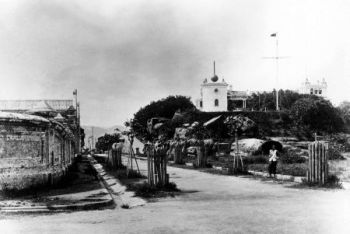
Time Ball at Tsim Sha Tsui Police Station (1885-1907)
Started to use a six-inch Lee Equatorial for astronomical observations.
|
| 1887 |
The first self-recording instrumental tidal measurement commenced operation in Victoria Harbour until 1889.
|
| 1890 |
Nighttime storm signals were introduced using two lanterns.
|
| 1892 |
Port meteorological service commenced.
|
| 1895 |
Started the provision of weather forecast for next 24 hours.
|
| 1907 |
The typhoon gun was replaced by explosive bombs. Started to use three vertically aligned lights as nighttime storm signal. When hurricane force winds affect Hong Kong, a black cross symbol would be hoisted above all the non-local storm signal code and the nighttime signal would be red-green-red.
|
| 1908 |
Weather reports from warships were received by wireless telegraphy.
The new time-ball tower on Signal Hill (also known as Tai Pau Mai or Blackhead Point) at Tsim Sha Tsui replaced the time-ball tower at the Marine Police Station at Tsim Sha Tsui.
|
| 1909 |
Production of daily weather map commenced. |
| 1912 |
King George V granted the title Royal Observatory, Hong Kong, in recognition of the Observatory's services.
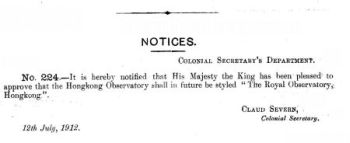
Extract of the Hong Kong Government Gazette published on 12 July 1912 showing the grant of the title of the Royal Observatory, Hong Kong
Mr. Thomas Folker Claxton, Director of the Royal Observatory, was elected as a member of Marine Meteorology and Storm Warning Committee of the International Meteorological Organization (IMO). This marked Hong Kong’s official participation in the work of IMO, which was the predecessor of the World Meteorological Organization (WMO).
|
| 1915 |
Started to receive weather reports from ships via the wireless station at Cape D’Aguilar and broadcast meteorological conditions, weather forecasts and typhoon warnings to the ships on a daily basis. |
| 1916 |
Full 24-hourly observations of the main meteorological elements began. |
| 1917 |
A visual system of tropical cyclone warning signals to indicate the wind likely to be experienced locally in Hong Kong was introduced in July. This was the first numbered signal system and it replaced the typhoon gun (audio) local storm signal which was operated since 1884. This visual system marks the origin of the current tropical cyclone warning system. |
| 1921 |
Pilot balloon observations began.
Seismological measurement began. |
| 1924 |
First survey of upper air temperatures by aircraft conducted. |
| 1926 |
Wireless station was established at the Observatory for weather broadcast. |
| 1927 |
Started to broadcast the typhoon warnings and weather forecast by voice via wireless station at the Observatory. |
| 1928 |
Started to broadcast weather forecasts and typhoon warnings through Radio Hong Kong. |
| 1929 |
Experiments conducted to produce rain using aircraft of the Royal Air Force.
Mr. Thomas Folker Claxton, Director of the Royal Observatory, attended the IMO Conference of Directors for the first time. |
| 1930 |
The Observatory first held the Conference of Directors of Far Eastern Weather Services in Hong Kong. Mr. Thomas Folker Claxton, Director of the Royal Observatory, was elected as the chairperson of the meeting. |
| 1931 |
The local tropical cyclone warning signal system introduced in 1917 was extended to ten signals with the No. 10 Signal being first used to warn hurricane force winds. |
| 1933 |
With the introduction and wider use of time signals on radio broadcast, the time ball at Signal Hill was dismantled on 30 June. |
| 1937 |
Aviation weather service commenced.
Hong Kong hosted the first Conference of the Regional Commission II of the International Meteorological Organization (IMO), the predecessor of the Regional Association II of the World Meteorological Organization. |
| 1938 |
The Far East Flying Training School began to provide the Observatory with upper air temperature and relative humidity data.
The Observatory’s Director, Mr. Charles Jeffries, was elected President of Regional Commission II of IMO. |
|
Second World War years |
| 1941-1945 |
During the Japanese occupation, the Observatory was forced to suspend its meteorological service. With the dedication of the imprisoned colleagues, the Observatory was able to maintain, on and off, part of its work.
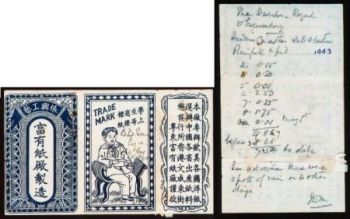
The rainfall records written on the back of a cigarette packet for April 1943. It can be faintly seen the signature of the Director of the Royal Observatory
|
|
Post War years |
| 1948 |
Hong Kong joined WMO as one of the founding regional members on 14 December. |
| 1949 |
Radiosonde and radarsonde ascents began.
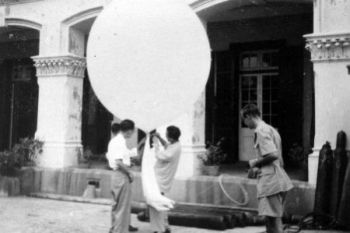
Launching of pilot balloon at the Observatory in 1950
Under the Voluntary Observing Ships' Scheme of the World Meteorological Organization, the Observatory started to recruit a fleet of locally based voluntary weather observing ships.
|
| 1951 |
The King's Park Radiosonde Station was commissioned. It was renamed the King's Park Meteorological Station in the 1960s.
|
| 1952 |
A minor tsunami generated by a severe earthquake in Kamchatka was detected by the automatic tide gauges for the first time.
|
| 1953 |
Radio Hong Kong began broadcasting hourly six-pip time signal provided by the Observatory on 11 April 1953.
Conducted the first measurement of upper-air winds on a Voluntary Observing Ship over the South China Sea using pilot balloons. |
| 1954 |
The Observatory installed the GL III windfinding radar to detect upper air winds. Besides, it was also used to detect nearby rain areas.
|
| 1955 |
The Observatory utilised a Decca 3 cm marine radar on loan from the Police to detect successfully distant rain echoes.
|
| 1956 |
The local tropical cyclone warning signal system was enhanced with the No. 3# Strong Wind Signal reinstated between the No. 1 Standby Signal and the gale signals No. 5 to 8.
# Signal No. 3 was not used in Hong Kong between 1935 and 1955.
|
| 1959 |
The first storm-detecting weather radar was installed at Tate's Cairn.
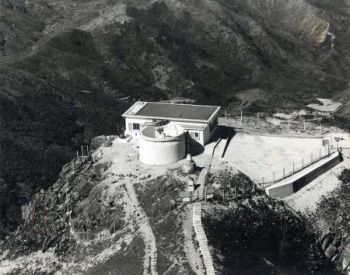
The Observatory's first storm-detecting weather radar, Decca 41, installed at Tate's Cairn in 1959
|
| 1961 |
The non-local storm signal system was completely dispensed with at the end of June.
Measurement of atmospheric radioactivity began.
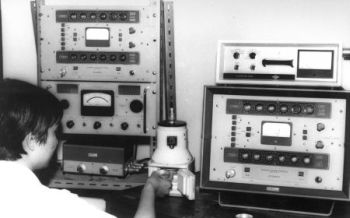
Measurement of atmospheric radioactivity
|
| 1962 |
Started the broadcast of storm news once every 15 minutes by radio broadcasters at the broadcast room of the Observatory.
|
| 1963 |
Since the adoption of the World Meteorological Organization resolution, the Observatory undertook the responsibility of collecting marine meteorological data in the region and published Marine Climatological Summaries annually. |
| 1964 |
Reception of Automatic Picture Transmission signal from polar-orbiting meteorological satellites.
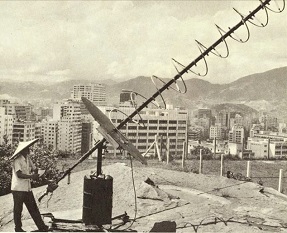 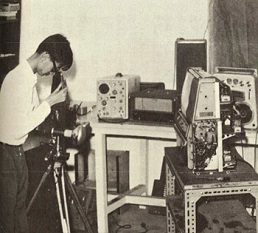 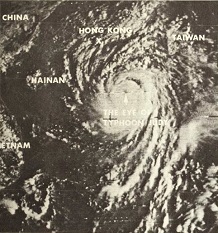
Receiving satellite pictures at King's Park Meteorological Station in the mid-1960s
|
| 1966 |
Direct broadcasting of a 6-pip time signal from the Observatory on 95 MHz commenced, and lasted till 16 September 1989. The broadcast of the Observatory's 6 pip time-signal by Radio Television Hong Kong (RTHK) continues to this date. |
| 1967 |
Started issuing thunderstorm warning and heavy rain warning (1967 – 1983). |
| 1973 |
The gale signals No. 5 to 8 in the local tropical cyclone warning signal system were replaced by 8NW, 8SW, 8NE and 8SE in 1973 so as to avoid misunderstanding by the public on the wind strength and direction.
The first computer system was installed.
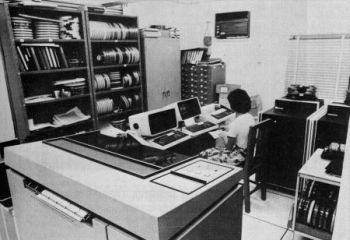
The Observatory's computer system in the 1970s
|
| 1975 |
The China Meteorological Administration and the Observatory signed an agreement in Beijing on establishing a meteorological telecommunications circuit to connect the computer systems at Beijing and Hong Kong.
Hong Kong completely integrated into WMO's Global Telecommunications System (GTS) with three point-to-point circuits :-
Hong Kong - Tokyo (1969)
Hong Kong - Bangkok (1970)
Hong Kong - Beijing (1975)
The development of the first numerical weather prediction model started.
|
| 1977 |
Started issuing landslip warning. |
| 1978 |
Reception of low-resolution satellite images from Geostationary Meteorological Satellite (GMS) of Japan Meteorological Agency.
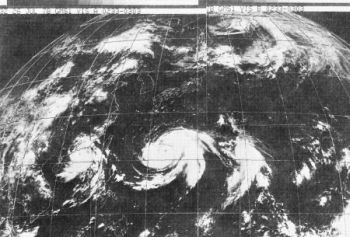
Low resolution GMS satellite image received on 26 July 1978. Shown on the image were (from left to right) Severe Tropical Storm Agnes, Typhoon Wendy and Typhoon Virginia
Forecast of tropical cyclones two days ahead introduced.
|
| 1979 |
A network of three short-period seismograph stations was established.
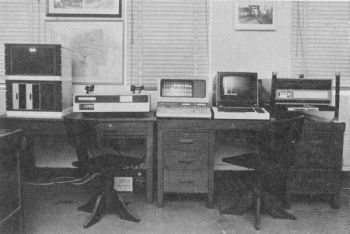
The seismic data acquisition and processing system
A numerical weather prediction model (the balanced barotropic model) was first operated on a routine basis.
Reception of high-resolution satellite images from Geostationary Meteorological Satellite (GMS) of Japan Meteorological Agency.
Five anemometers were installed over Kowloon city area and the runway at Kai Tak International Airport for experimental windshear detection over the airport.
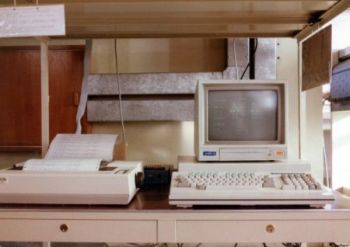
The experimental windshear alerting system at Kai Tak International Airport
|
| 1980 |
A timing system based on a Caesium Beam Atomic Clock was acquired.
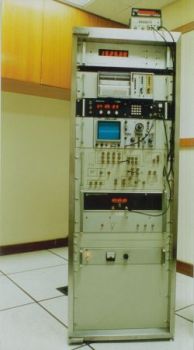
The Observatory's first caesium beam atomic clock
|
| 1982 |
Commenced the operation of real-time rainfall data acquisition system. |
| 1983 |
Commenced provision of 3-day weather forecasts. |
| 1984 |
The first two Automatic Weather Stations were established at the Observatory's Headquarters and Sha Tin for providing public weather services. Another one was put into operation at Chek Lap Kok for providing aviation weather services.
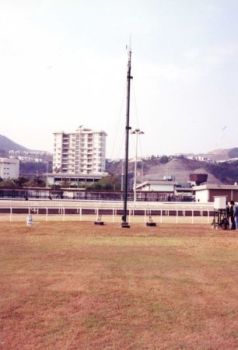
Shatin Automatic Weather Station
An agreement was signed with Guangdong Meteorological Bureau on Mutual Co-operation to jointly establish an Automatic Weather Station.
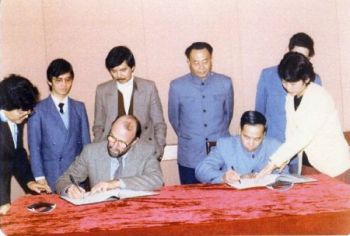
The Director of the Royal Observatory (left) signing an agreement with the Director of Guangdong Meteorological Bureau (right)
|
| 1985 |
The first automatic weather station jointly built by the Royal Observatory and the Guangdong Meteorological Bureau, commenced operation at Huangmao Zhou.
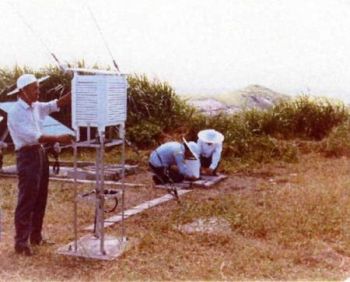
Installing the instruments at Huangmao Zhou
Dial-a-weather system was installed for the public.
|
| 1986 |
Public weather services went fully metric.
A radiation laboratory was set up at King's Park to perform radiological analysis of environmental samples.
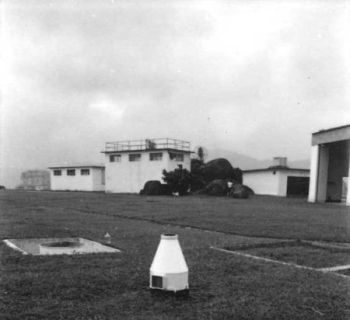
King's Park Radiation Laboratory at the background (with railings on top)
|
| 1987 |
The Environmental Radiation Monitoring Programme was established.
Observatory's scientific officers began hosting TV weather programmes.
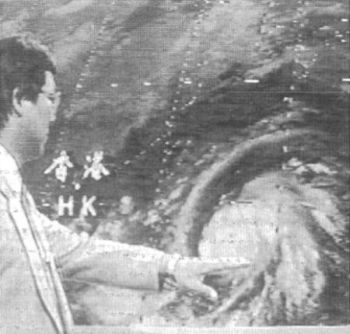
A professional meteorologist appearing in a weather programme on television
|
| 1988 |
A new numerical weather prediction model (the Limited Area Model) focusing on small scale weather disturbances affecting Hong Kong and its vicinity was implemented.
Weather information and forecast for 23 world cities was sent to Government Information Services and Radio Television Hong Kong for dissemination to the media and the public.
The Observatory compiled the first publication on climate change in Hong Kong.
The first radiological survey vehicle was put into operation. It was equipped with custom-designed instruments to carry out radiological surveys at various parts of the territory.
|
| 1990 |
The Monitoring and Assessment Centre (radiological) was established. |
| 1992 |
A colour coded Red and Black Rainstorm Warning System was introduced. |
| 1993 |
Measurement of ozone and radioactivity in the upper atmosphere started.
A Liaison Group for Aviation Weather Services was established, the first user group of the Observatory to engage user communities. |
| 1994 |
The first Doppler weather radar started operation.
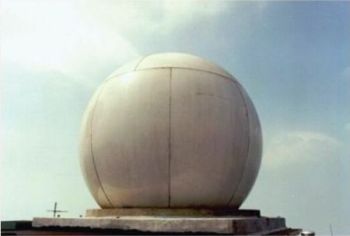
The first S-band Doppler weather radar installed at Tate's Cairn
|
|
Internet era |
| 1996 |
The Observatory home page was launched on the Internet.
The "Friends of the Observatory" was established to enhance communication with the public and to promote public understanding of weather services.
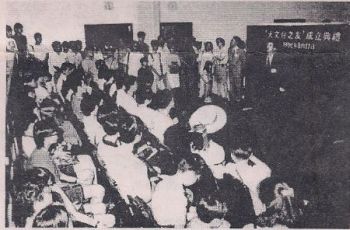
The inauguration ceremony of the "Friends of the Observatory"
The Observatory installed the first wind profiler in Hong Kong at Sham Shui Po.
|
| 1997 |
The Observatory resumed its original name "Hong Kong Observatory".
The seismological network was upgraded to a digital network with eight stations.
The Observatory installed an aerial radiation monitoring system to enhance its capability in environmental radiation monitoring.
The first C-band Terminal Doppler Weather Radar commenced operation for windshear monitoring.
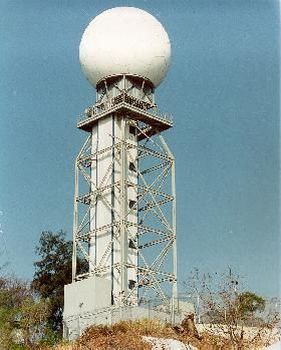
The Observatory's Terminal Doppler Weather Radar
|
| 1998 |
Range of forecast period for public weather forecast extended to 4 days.
Aviation Meteorological Office was relocated from the old airport at Kai Tak to the new Hong Kong International Airport at Chek Lap Kok in July 1998.
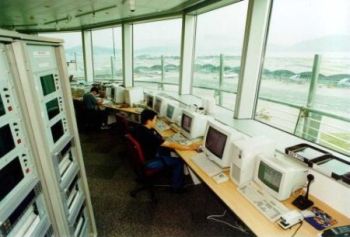
The Chek Lap Kok Airport Meteorological Office commenced provision of aviation weather services for the new airport on 6 July 1998
The rainstorm warning system was revised to adopt a 3-level warnings classified as "Amber", "Red" and "Black" rainstorm warning signals.
Started using the aerial radiation monitoring system to conduct aerial radiological surveys over the territory.
|
| 1999 |
The Observatory commissioned the second S-band Doppler weather radar at Tai Mo Shan – the highest peak in Hong Kong.
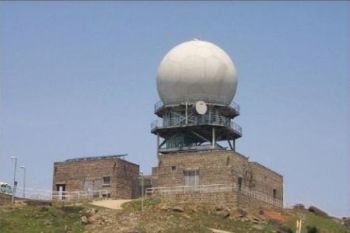
Observatory's weather radar at Tai Mo Shan
A super-computer was acquired for the operation of a high resolution numerical weather prediction system (Operational Regional Spectral Model) and to enhance the capability of rainstorm forecasting.
An in-house developed rainfall nowcasting system, known as "Short-range Warning of Intense Rainstorms in Localized Systems", was put into operation.
Cold Weather Warning was introduced.
Provision of UV index commenced.
The Observatory and the Air Traffic Management Bureau (ATMB) of the Civil Aviation Administration of China signed a "Memorandum on Long Term Technical Cooperation in Aviation Meteorological Services"
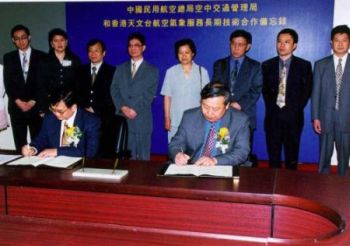
The Director of the Hong Kong Observatory (left) and Director of the Meteorological Division of ATMB (right) signing the "Memorandum on Long Term Technical Cooperation in Aviation Meteorological Services"
|
| 2000 |
Operation of 5-day weather forecast commenced.
Very Hot Weather Warning was introduced.
The Observatory signed the "Agreement on Co-operation in Seismology between the China Earthquake Administration and the Hong Kong Observatory" with the China Earthquake Administration.
|
| 2001 |
The first mobile version of the Observatory's website was launched.
The first weather buoy in Hong Kong commenced operation.
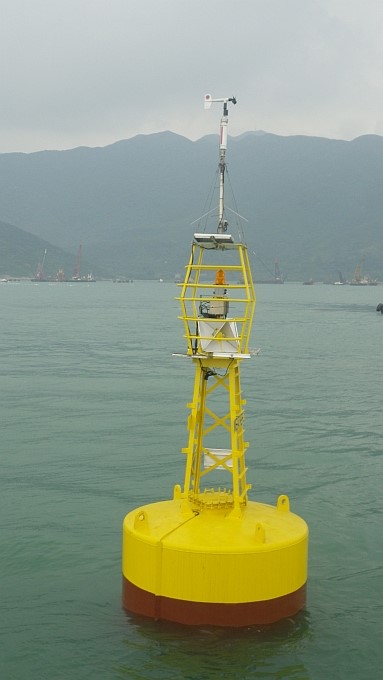
A weather buoy installed to the west of Chek Lap Kok in Hong Kong
Forecast of annual rainfall and the number of tropical cyclones affecting Hong Kong was made available to the public.
Severe Weather Information Centre (SWIC) website, developed and hosted by the Hong Kong Observatory on behalf of the World Meteorological Organization, was launched. This was the first international Internet website of official weather warnings around the world.
The Observatory signed the "Arrangement on Long Term Co-operation between the China Meteorological Administration and the Hong Kong Observatory" with the China Meteorological Administration.
|
| 2002 |
The "World Weather Information Service" website, which was developed and hosted by the Observatory on behalf of the World Meteorological Organization, was launched. This was the first international Internet web site of official weather forecasts for cities around the world.
The Observatory installed the world's first LIght Detection And Ranging (LIDAR) system for use in airport weather alerting at Chek Lap Kok.
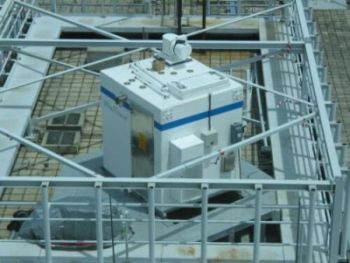
The LIDAR on the roof-top of the Air Traffic Control Complex at Chek Lap Kok
The Observatory's aviation weather service received ISO 9001:2000 accreditation.
The last operating signal station at Cheung Chau was decommissioned on 1 January. It marked the end of an era of visual warning signals display at signal stations.
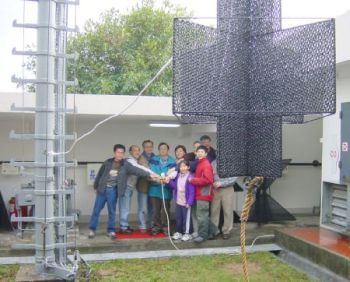
The Director of the Hong Kong Observatory (4th from left), officiating at the closing ceremony of Cheung Chau signal station by lowering the No. 10 signal
|
| 2003 |
Automatic weather reports were successfully received for the first time from commercial aircraft.
Range of forecast period for public weather forecast extended to 7 days.
Tropical cyclone forecast extended from two days to three days ahead. |
| 2004 |
The Observatory started operating the first automatic Upper-air Sounding System in Southeast Asia.
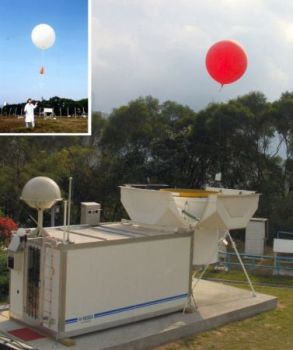
The Automatic Upper-air Sounding System at the King's Park Meteorological Station replacing manual launching of balloon
Time information of the Observatory's atomic clock was provided to the International Bureau of Weights and Measures (BIPM), contributing to determining the co-ordinated universal time (UTC).
The Observatory became the first weather service in Asia to operationally receive and disseminate automatic weather reports from commercial aircraft.
The first ground-based microwave radiometer was installed in Hong Kong for trial run.
The Observatory completed the first study of climate projection for Hong Kong for the next century.
|
| 2005 |
The Observatory set up a lightning location network in cooperation with the Guangdong Meteorological Bureau and the Macao Meteorological and Geophysical Bureau, and launched the lightning location information service.
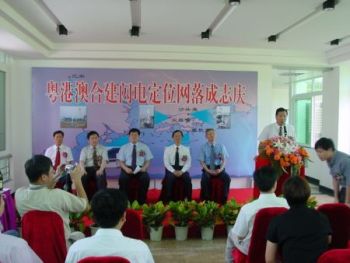
Press Conference covering the Inauguration Ceremony of the Pearl River Estuary Lightning Location Network set up jointly by Guangdong, Hong Kong and Macao
The world's first LIDAR Windshear Alerting System developed by the Observatory for providing windshear alerting service began operation at the Hong Kong International Airport. It also received the highest award, Award of the Year of the 2009 Hong Kong Information and Communications Technology Awards.
The Observatory commenced reception of satellite images from geostationary meteorological satellites in Fengyun-2 series of China and Japan's "Multi-functional Transport Satellite-1R (MTSAT-1R)".
|
| 2006 |
The Observatory launched the Ultraviolet (UV) Index forecast service.
The Observatory issued a Tsunami Information Bulletin for the first time for a severe earthquake that occurred over the Luzon Strait.
The Observatory operated the first climate prediction model to support the provision of seasonal forecast. |
| 2007 |
Launch of the Hong Kong Community Weather Information Network, making available to the public on the internet weather information collected by local schools and organizations.
The "One District One Station" project was launched with the establishment of an automatic weather station at Central and Western District at Hong Kong Park .
The State Oceanic Administration (SOA) and the Observatory signed an agreement on co-operation in oceanography in Hong Kong.
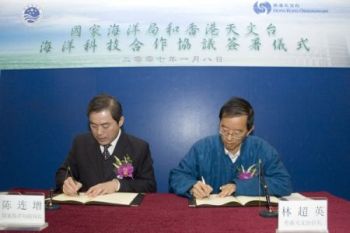
The Deputy Director of the State Oceanic Administration (left), and Director of the Hong Kong Observatory (right) signing the agreement on co-operation in oceanography
|
| 2008 |
The first regional temperature forecast was launched on the Observatory's website.
The automatic Airport Thunderstorm & Lightning Alerting System was launched.
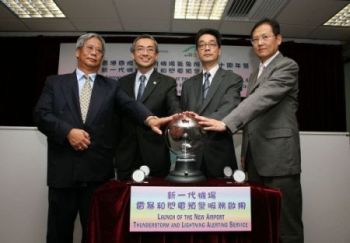
Launch of the airport thunderstorm and lightning alerting service
|
| 2009 |
The Observatory successfully registered a patent in Hong Kong for its in-house developed "Heat Stress Monitoring System".
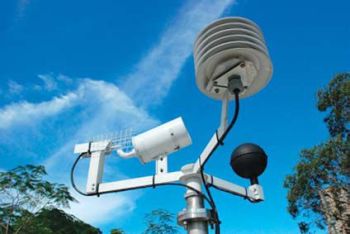
The Observatory's in-house developed "Heat Stress Monitoring System"
The Observatory's Radiation Laboratory received ISO 9001:2008 accreditation.
The Observatory launched weekly programmes on YouTube.
The Observatory started measurement of carbon dioxide concentration at King's Park Meteorological Station.
|
| 2010 |
Mr. Shun Chi-ming, Assistant Director of Hong Kong Observatory, was elected President of Commission for Aeronautical Meteorology of the World Meteorological Organization (WMO), the highest position in WMO ever taken by Observatory's staff.
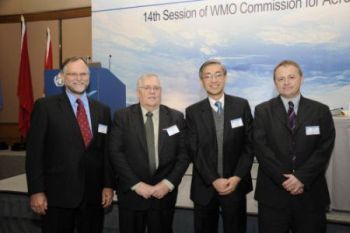
The newly elected President of the Commission for Aeronautical Meteorology and Assistant Director of Hong Kong Observatory, Mr. C. M. Shun (second from right) pictured with the two former Presidents of the Commission, Dr Neil Gordon (1999 - 2006, left) and Mr. Carr McLeod (2006 - 2010, second from left)
Dissemination of weather information to the public through social networking platform (Twitter) commenced.
The mobile device application "MyObservatory" providing weather information to people on the move was launched.
A Liaison Group for the Shipping Community was established.
The Observatory commissioned the Po Shan Seismograph Station to enhance monitoring of earthquakes in the South China Sea. The station became a member of the Global Seismographic Network.
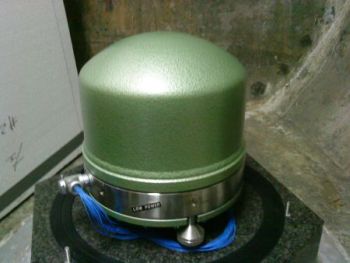
The broadband seismometer in the Po Shan Seismograph Station
|
| 2011 |
The Observatory collaborated with Government Flying Service to deploy a fixed-wing aircraft for collecting meteorological data on tropical cyclones over the South China Sea for the first time.
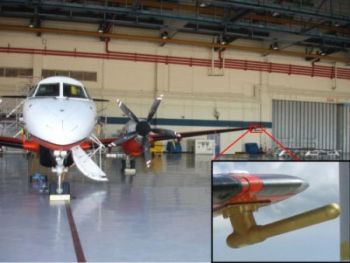
The meteorological measuring system installed on the fixed-wing aircraft, with the inset showing the air data probe on the wing tip
A quick earthquake message service, speeding up the delivery of earthquake reports to about 10 minutes on average, was launched.
The Observatory launched the Greater Pearl River Delta Weather website jointly with the Guangdong Meteorological Bureau and the Macao Meteorological and Geophysical Bureau.
The Observatory launched the "MyWorldWeather" mobile weather application on behalf of the World Meteorological Organization, which is the first mobile device application, providing official weather forecasts for cities around the world.
The Observatory signed a Long-term Co-operation Agreement in Numerical Weather Prediction Technology with the Shenzhen Meteorological Bureau.
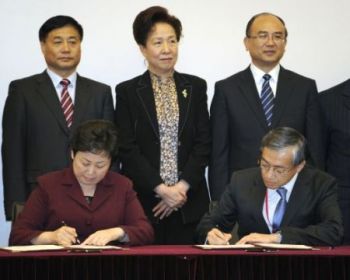
Director of the Hong Kong Observatory (right) signing the Long-term Co-operation Agreement in Numerical Weather Prediction Technology with Director-General of Shenzhen Meteorological Bureau (left)
Launched 1-day “Digital Weather Forecast” of temperature and winds.
|
| 2012 |
Webcast of Observatory's astronomical observation for the first time.
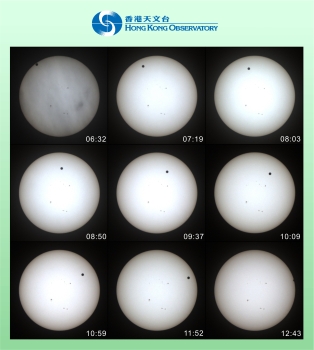
Transit of Venus on 6 June 2012
The first X-band Doppler weather radar was commissioned.
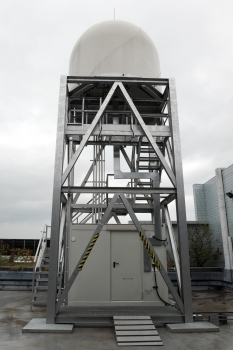
The X-band Doppler weather radar at Siu Ho Wan, Lantau Island
A personalized service of rain forecast for the next 2 hours was launched on "MyObservatory" mobile app.
The Observatory signed a Memorandum of Understanding on co-operation with the Korean Meteorological Administration.
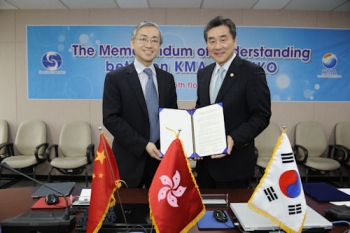
The Director of the Hong Kong Observatory, Mr Shun Chi-ming (left) and the Administrator of Korea Meteorological Administration, Mr Cho Seok Joon (right), after the signing of the Memorandum of Understanding
The Observatory signed a Long-term Co-operation Agreement in Numerical Weather Prediction Technology with the Guangdong Meteorological Bureau.
|
| 2013 |
Launched the Observatory mascot “Dr. Tin” to help promote public education activities.
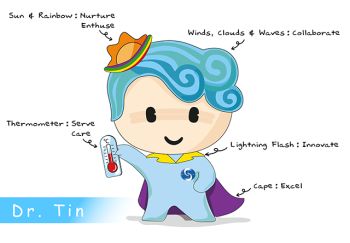
The Observatory mascot "Dr. Tin"
Usage of the mobile application “MyObservatory” (in number of page views) exceeded that of the Observatory website for the first time.
Hong Kong Voluntary Observing Ship (VOS) was equipped with automatic weather station (AWS) for the first time to provide more frequent and timely marine meteorological observations. At the same time, part of the VOS fleet started to be upgraded to VOS Climate (VOSClim) to provide high-quality marine meteorological observations supporting global climate studies.
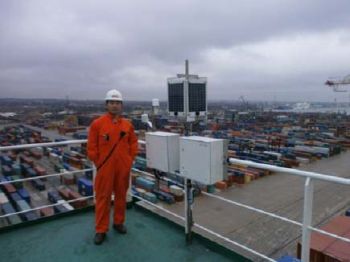
AWS installed on board the Hong Kong Voluntary Observing Ship
The Observatory started to acquire real-time Guangdong seismic data to the Hong Kong seismic monitoring network for enhancing the capability of monitoring local and nearby earthquakes.
Launched a free public TV weather service, through which weather programmes, including a weekly educational feature named “Cool Met Stuff”, produced in-house by the Observatory were broadcast on TV, YouTube and the “MyObservatory” mobile application.
The Observatory participated in the Twelfth Session of Working Group I of the United Nations Intergovernmental Panel on Climate Change, which approved the Summary for Policymakers of the Fifth Assessment Report.
Launched GIS-based automatic regional weather forecast for 7 days.
|
| 2014 |
Extended the period of weather forecast to 9 days.
Launched the service on Hot Weather Special Advisory and provided the Hong Kong Heat Index on the Observatory's website for monitoring hot weather conditions.
Set up the Data Collection or Production Centre for the “World Weather Information Service” (WWIS) to facilitate search and subscription of weather information. A newly revamped website for the WWIS was also launched.
Observatory’s weather information service was launched on the WeChat social media platform.
The second C-band Terminal Doppler Weather Radar station near Brothers Point was commissioned.
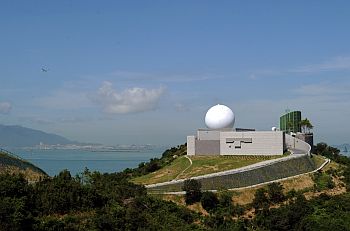
Brothers Point Terminal Doppler Weather Radar Station
The Observatory signed a co-operation agreement with the Environmental Radiation Monitoring Technical Center of the Ministry of Environmental Protection, the first technical co-operation agreement between the Observatory and an environmental radiation monitoring service in the Mainland.
The Observatory signed a Letter of Intent on Cooperation with the China Institute of Atomic Energy and the Shanghai Radiation Environmental Supervision Station.
The Observatory signed a "Co-operation Agreement in Meteorological Science and Technology" with the Guangdong Meteorological Bureau.
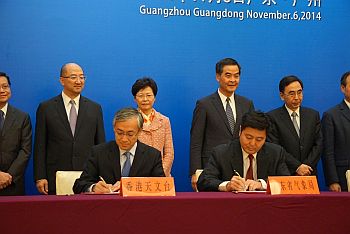
Mr Shun Chi-ming (left front), Director of the Hong Kong Observatory, and Mr Zou Jianjun (right front), Acting Director-General of Guangdong Meteorological Bureau, signed the "Co-operation Agreement in Meteorological Science and Technology" in Guangzhou.
The Observatory started to recruit Ambassadors of Weather Observation from the active members of the Facebook of the Community Weather Observing Scheme (CWOS), air scouts and air cadets, as well as the Friends of the Observatory with a view to promoting public education on weather and climate.
Mr. Shun Chi-ming, Director of the Hong Kong Observatory, was re-elected President of the Commission for Aeronautical Meteorology (CAeM) of the World Meteorological Organization.
|
| 2015 |
Conducted the first ever attempt to deploy a drifter buoy over the South China Sea to measure atmospheric pressure and sea surface temperature.
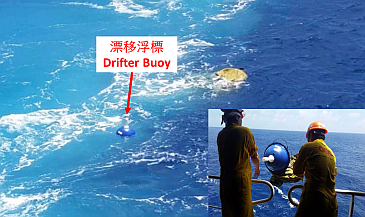
The first drifter buoy for oceanographic and meteorological observations was deployed over the South China Sea
Tropical cyclone forecast extended from three days to five days ahead.
The first dual-polarisation S-band Doppler weather radar installed at Tate's Cairn started operations.
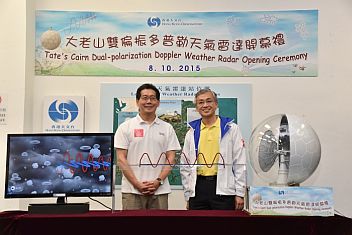
Mr Gregory So (left), Secretary for Commerce and Economic Development, and Mr CM Shun (right), Director of the Hong Kong Observatory, officiated at the opening ceremony of the first dual-polarization weather radar in Hong Kong
The Observatory received ISO 9001 accreditation for its Ambient Gamma Radiation Level Measurement Service in October.
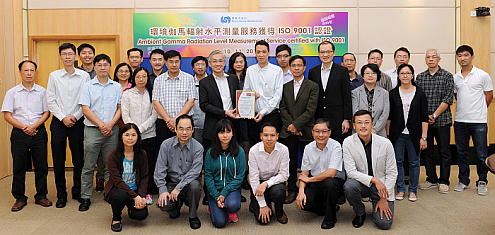
Staff of the Observatory celebrating the ISO 9001 accreditation for its Ambient Gamma Radiation Level Measurement Service
|
| 2016 |
Launched the "Announcement on Localised Heavy Rain" service for alerting of potential serious flooding due to heavy rain in individual district(s) that does not yet warrant the issuance of Red or Black Rainstorm Warning Signal.
Launched a new version of the MyObservatory for the iOS platform, supporting the Apple Watch for the first time, providing current and forecast weather information on the Watch.
Introduced a dropsonde system to strengthen monitoring of tropical cyclones in collaboration with the Government Flying Service.
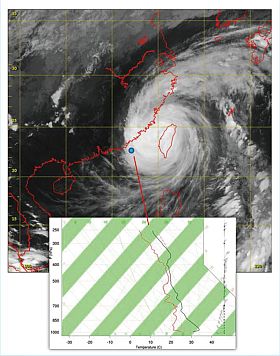
Vertical profile of meteorological parameters from the first dropsonde mission in the South China Sea around Typhoon Megi on 27 September 2016
Signed a tripartite agreement with the Civil Aviation Administration of China and the China Meteorological Administration to jointly establish the "Asian Aviation Meteorological Centre" with Hong Kong serving as the backup centre.
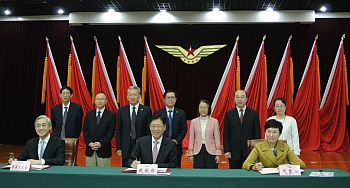
Director of the Hong Kong Observatory, Shun Chi-ming (left, front row); Deputy Administrator of the Civil Aviation Administration of China, Wang Zhiqing (centre, front row); and Deputy Administrator of the China Meteorological Administration, Jiao Meiyan (right, front row), signed a co-operation agreement on the joint establishment of the "Asian Aviation Meteorological Centre".
|
| 2017 |
The Observatory received ISO 9001:2015 accreditation for its public weather services.
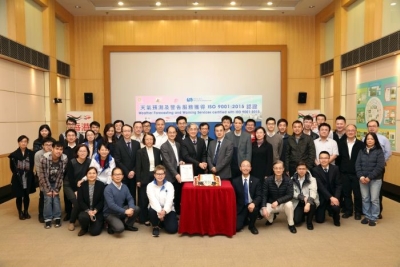
Staff of the Observatory celebrating the ISO 9001 certification for its public weather services.
Observatory headquarters received WMO’s recognition of centennial observing station.
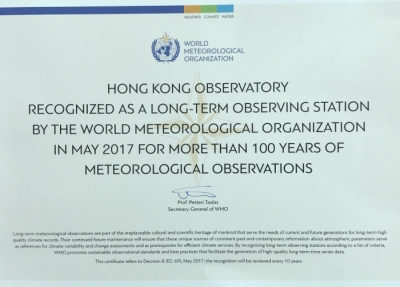
The long-term observing station accreditation certificate awarded to the Observatory by the World Meteorological Organization.
Launched the online version of the “International Cloud Atlas” developed for the World Meteorological Organization.
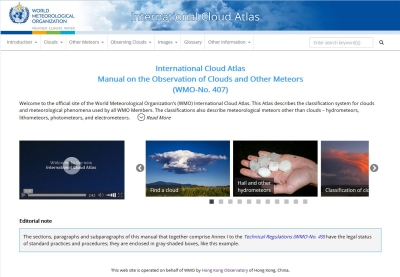
Online version of the “International Cloud Atlas”.
Launched the electronic flight bag application “MyFlightWx”.

Director of the Hong Kong Observatory, Mr Shun Chi-ming (right) and the General Manager Operations of Cathay Pacific Airways, Captain Mark Hoey (left) demonstrated the use of “MyFlightWx” inside a flight simulator.
Signed a Letter of Intent on Cooperation with the China Institute for Radiation Protection.
Signed a Memorandum of Understanding on Cooperation with the Thai Meteorological Department.
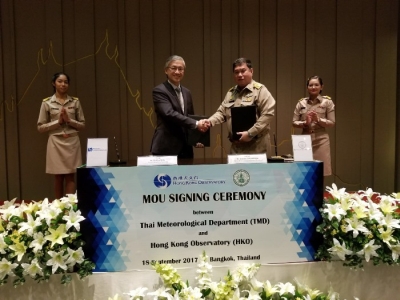
Signing Ceremony of Memorandum of Understanding between the Observatory and Thai Meteorological Department.
|
| 2018 |
Launched HKO Facebook page and Instagram platform.
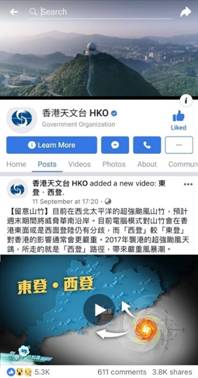 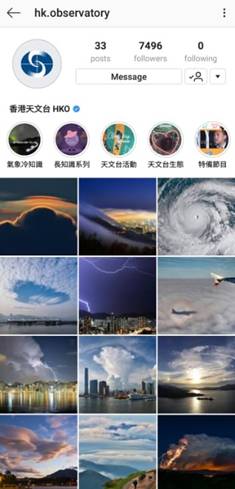
HKO Facebook page (left) and Instagram platform (right).
Asian Aviation Meteorological Centre (AAMC) jointly established by Civil Aviation Administration of China, China Meteorological Administration and Hong Kong Observatory commenced operation.
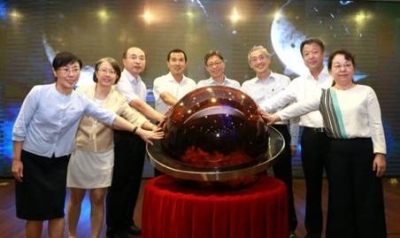
Director of the Hong Kong Observatory, Shun Chi-ming (third right) and other guests officiating at the launch ceremony of the AAMC in Beijing.
Launched the World Meteorological Organization's (WMO) Global Multi-hazard Alert System (GMAS) for Asia in collaboration with the China Meteorological Administration.
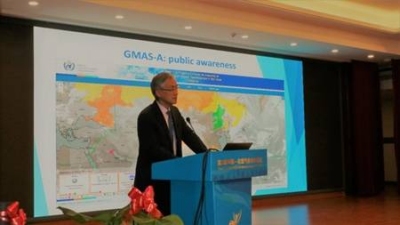
Launch of the WMO's GMAS for Asia.
Launched "Severe Weather Information Centre" SWIC 2.0 to aggregate official weather warnings around the world.
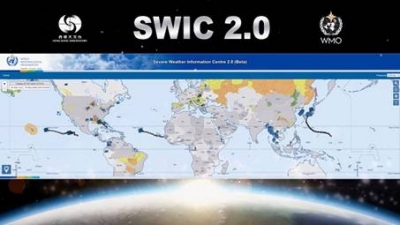
Revamped Severe Weather Information Centre (SWIC 2.0) website.
The Observatory was designated by the World Meteorological Organization (WMO) as the Regional Specialized Meteorological Centre (RSMC) for Nowcasting for the Asian region.
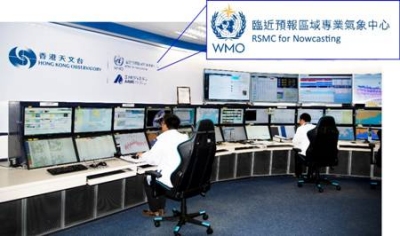
RSMC for Nowcasting at the Observatory.
Signed a Memorandum of Understanding with the World Meteorological Organization (WMO) to strengthen mutual cooperation.
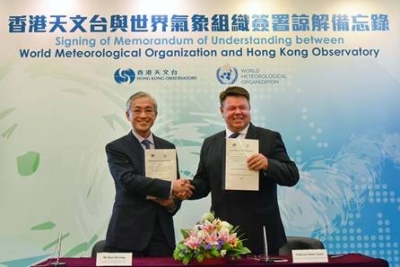
Director of the Hong Kong Observatory, Shun Chi-ming and Secretary-General of the WMO, Petteri Taalas, signed the Memorandum of Understanding.
|
| 2019 |
The Director of the Hong Kong Observatory, Shun Chi-ming was elected a co-Vice-President of the Commission for Weather, Climate, Water and Related Environmental Services and Applications of the World Meteorological Organization.
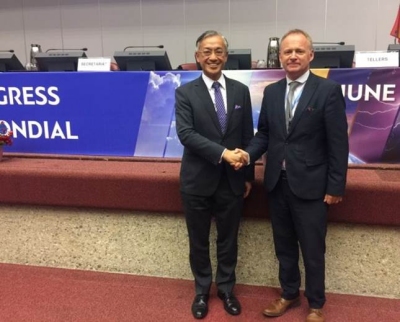
Photo of Director of the Hong Kong Observatory, Mr Shun Chi-ming and the President, Mr Ian Lisk.
The short-range LIDAR installed close to the North Runway of the Hong Kong International Airport.
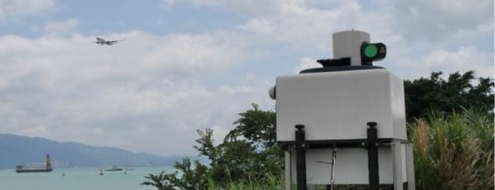
The short-range LIDAR.
Launch “Greater Bay Area Weather Website”, providing actual weather reports, weather warnings, and forecast up to 7 days for over 60 regions in 11 cities of the area.
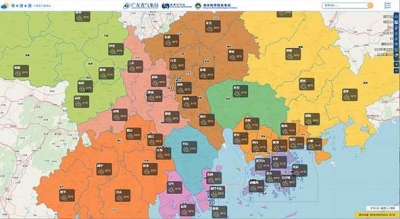
The website provides weather information for over 60 regions in 11 cities of the area.
Collaborated with the Ho Koon Nature Education cum Astronomical Centre to compile "Geography E-learning Package about Climate Change".
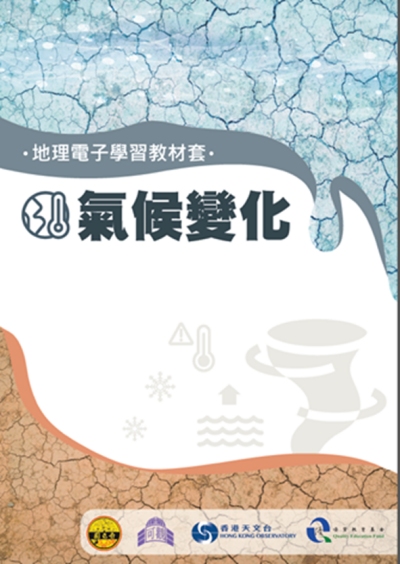
The cover of "Geography E-learning Package about Climate Change".
A new song “Climate and Life” on climate change was jointly produced with a local singer.

The Observatory released the new song “Climate and Life” on climate change.
The electronic flight bag application "MyFlightWx" officially commenced operation in both Cathay Pacific and Cathay Dragon flights.
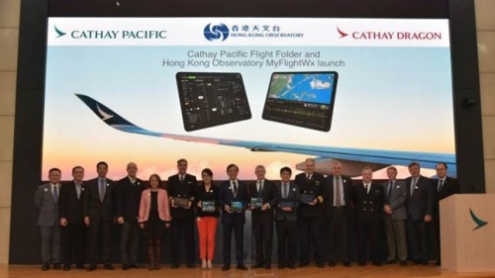
Director of the Hong Kong Observatory, Mr Shun Chi-ming (eighth left) and other guests of Cathay Pacific Airways officiating at a ceremony to celebrate the flights of Cathay Pacific and Cathay Dragon going completely paperless.
The Logo of the Observatory registered as a trade mark.
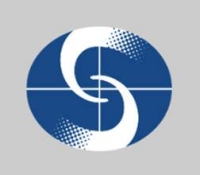 
The Observatory Logo.
The Hong Kong Observatory Intern Alumni Network (HKOIAN) was established.
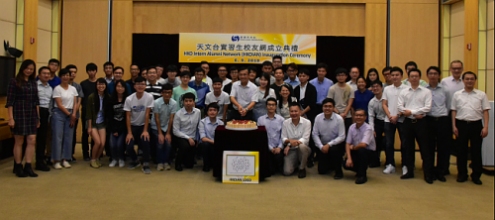
HKOIAN Inauguration Ceremony.
|
| 2020 |
Launched the “Online Video Course on Weather Observation” for the first time, explaining concisely the basic weather observation methods and techniques.
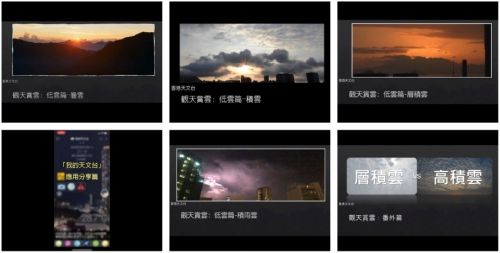
Online Video Course on Weather Observation.
Launched the trial version of the “Dr Tin” chatbot artificial intelligence service on “MyObservatory” app, HKO website and HKO Facebook page.

“Dr Tin” chatbot.
The King's Park upper-air meteorological station participated in the Global Climate Observing System Reference Upper-Air Network (GRUAN) of the World Meteorological Organization, and launched balloon with frostpoint hygrometer to measure upper-air water vapour content for the first time.
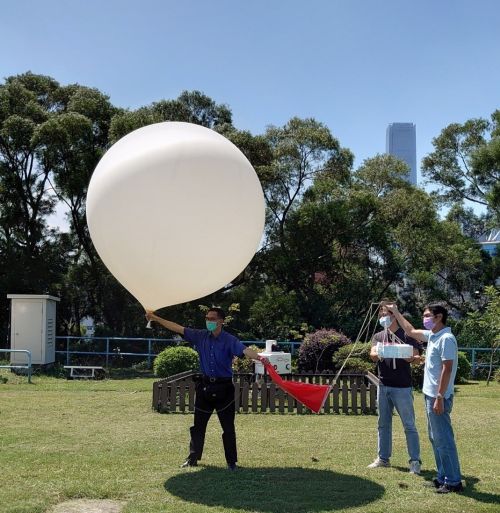
Launching the balloon to collect water vapour content data.
Launched 360 degree virtual tour for the first time to enable the public to tour around the Observatory’s facilities online.
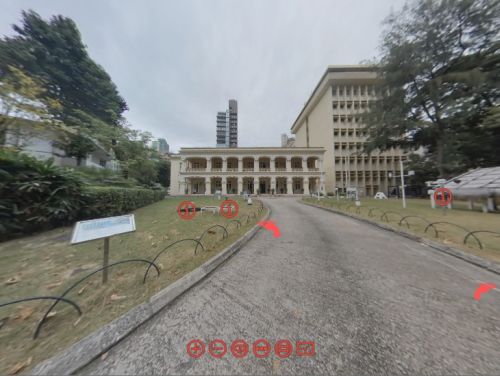
360 Degree Virtual Tour to the Meteorological Garden of the Hong Kong Observatory.
The Hong Kong Observatory successfully registered a patent in Hong Kong for its in-house developed bollard style automatic weather station.
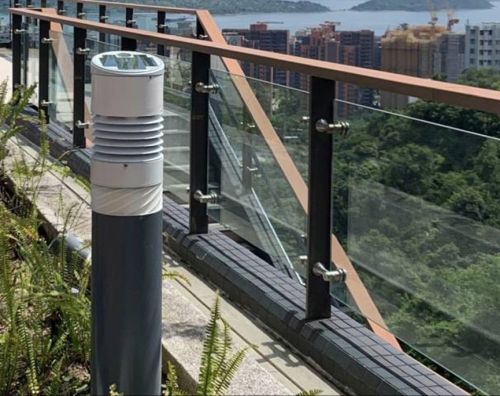
A bollard style automatic weather station installed at the Chinese University of Hong Kong.
|
| 2021 |
Organised public online polling campaign “2016-2020 Top 10 Mind-boggling Weather and Climate Events Selection” to arouse public awareness and attention to extreme weather and climate change.
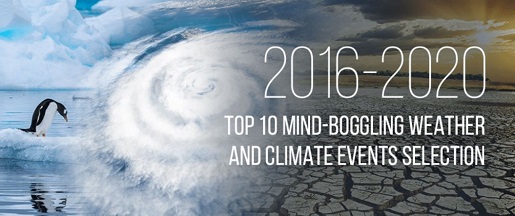
Organised public online polling campaign “2016-2020 Top 10 Mind-boggling Weather and Climate Events Selection”
Launched the 9-day “Probability of Significant Rain” forecast to provide the predicted probability of daily cumulative rainfall reaching 10 mm or above generally over Hong Kong for the public.
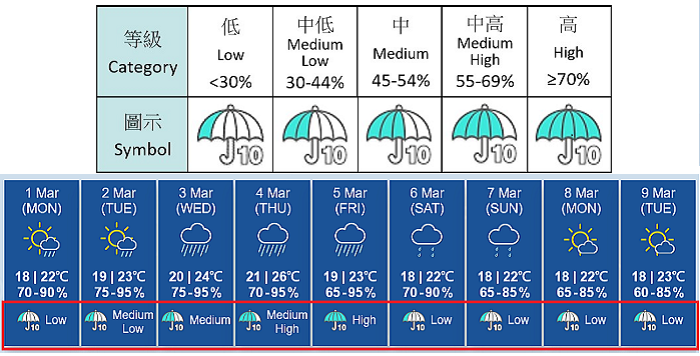
Launched the 9-day “Probability of Significant Rain” forecast
The Observatory Open Day 2021 was held online for the first time to take the public on a journey to explore the Observatory Headquarters through virtual tours.
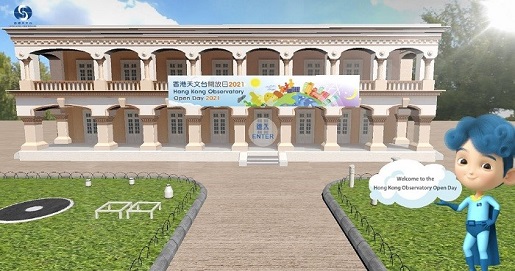
“Hong Kong Observatory Open Day 2021” webpage
Launched the “Localised Heavy Rain Advisory” service with reference to both recorded rainfall and nowcast rainfall for early preparation of the public.
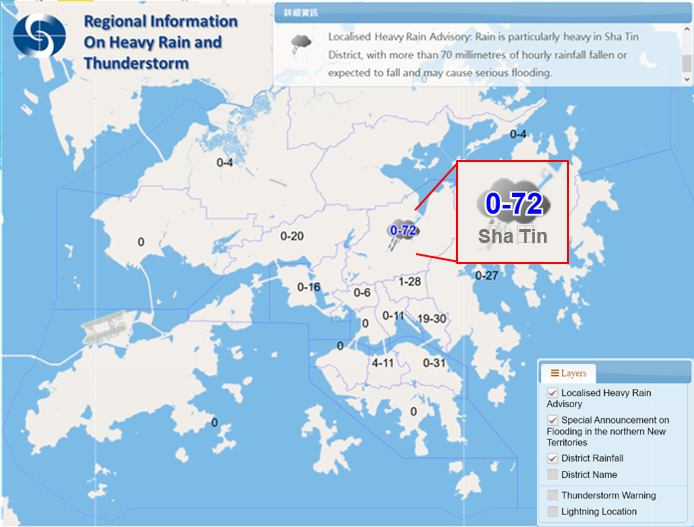
Launched the “Localised Heavy Rain Advisory” service
Launched a new personalised weather website to provide basic weather information in eight ethnic minority languages.
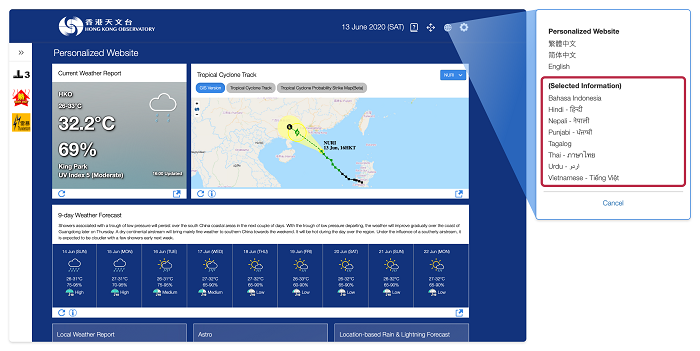
Launched a new personalised weather website
Launched an e-book "A Tour of Tropical Cyclones" to promote children’s understanding of tropical cyclones and raise their awareness of disaster preparedness.
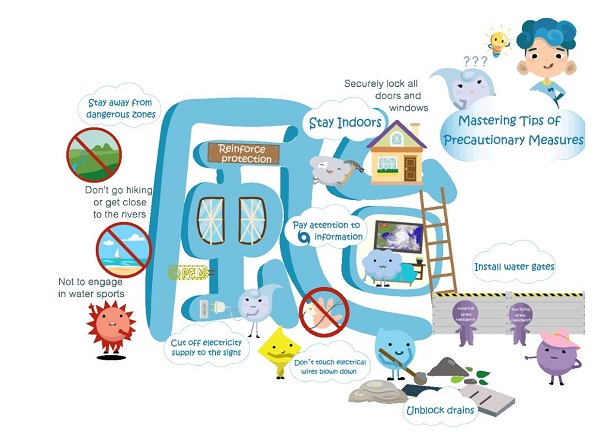
Launched a children’s e-book "A Tour of Tropical Cyclones"
The upper air observing station of the Observatory became the world's first centennial upper air observing station accredited by the World Meteorological Organization (WMO).
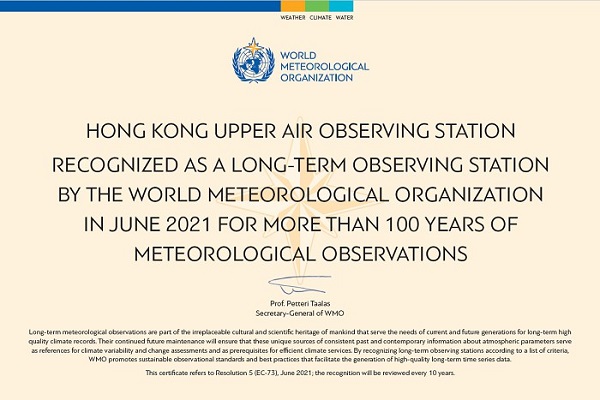
The centennial observing station accreditation certificate awarded by the World Meteorological Organization to the upper air observing station of the Observatory
Rolled out a trial function “My Weather Observation” on “MyObservatory” app to enable the public to report and share weather information.
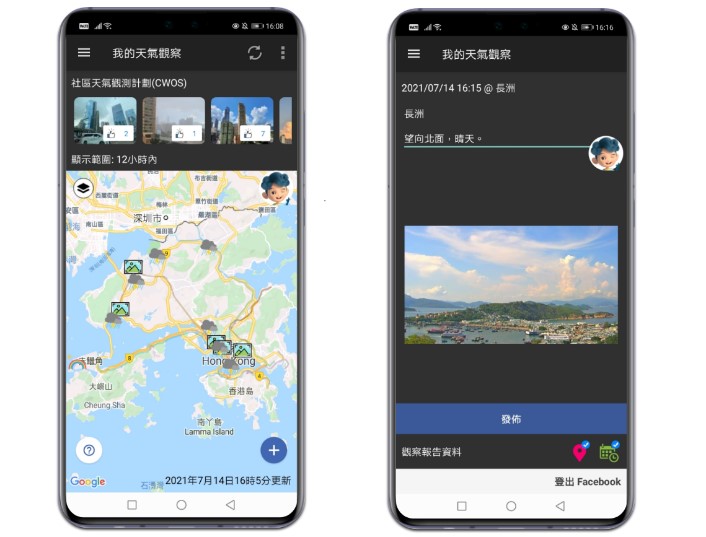
My Weather Observation
The first Phased Array Doppler Weather Radar started trial operation.
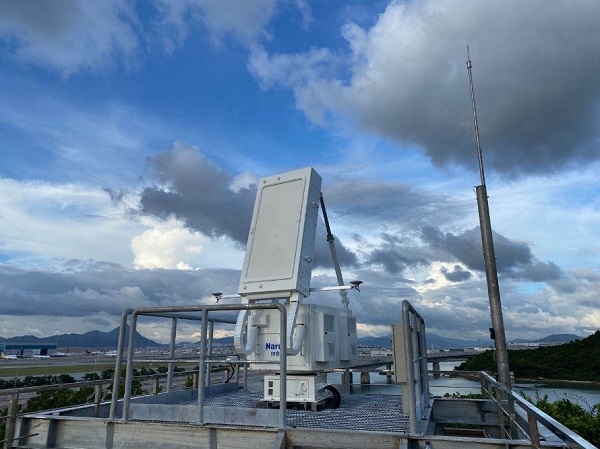
The first Phased Array Doppler Weather Radar installed at Sha Lo Wan
The first regional climate model commenced operation for generation of climate projections.
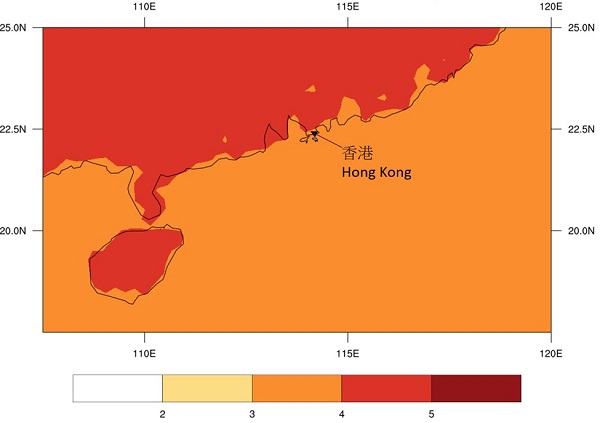
Change in annual maximum temperature in the south China coastal areas by end-century under high greenhouse gas concentration scenario (°C)
|
| 2022 |
HKO provided aviation weather services and implemented meteorological equipment to support operation of the Third Runway of the Hong Kong International Airport.
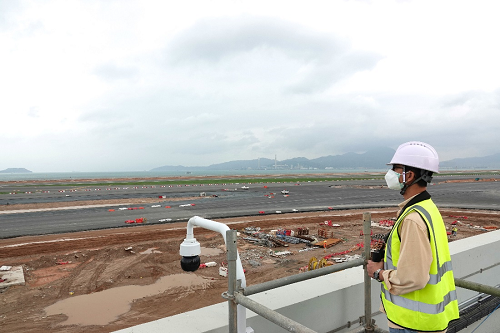
Weather observer making weather observations to support operation of the Third Runway
The energy conservation collaboration project between the Observatory, Hong Kong Airport Authority, and CLP Power Hong Kong on “Big Data Analytic for Energy Management at Hong Kong International Airport” was awarded the Asia Pacific Rim Region Energy Project of the Year Award by the Association of Energy Engineers.
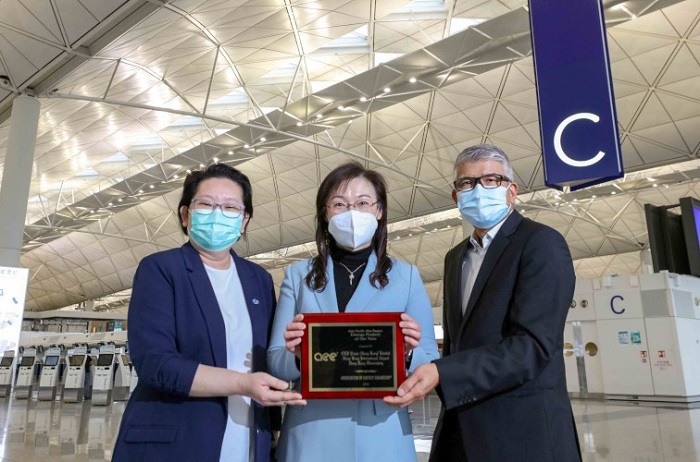
The energy conservation collaboration project between the Observatory, Hong Kong Airport Authority, and CLP Power Hong Kong on “Big Data Analytic for Energy Management at Hong Kong International Airport” was awarded the Asia Pacific Rim Region Energy Project of the Year Award by the Association of Energy Engineers
The Information Technology (IT) service management system supporting the critical infrastructures of the Observatory was awarded the International Organisation for Standardization/International Electrotechnical Commission (ISO/IEC) 20000-1:2018 certification.
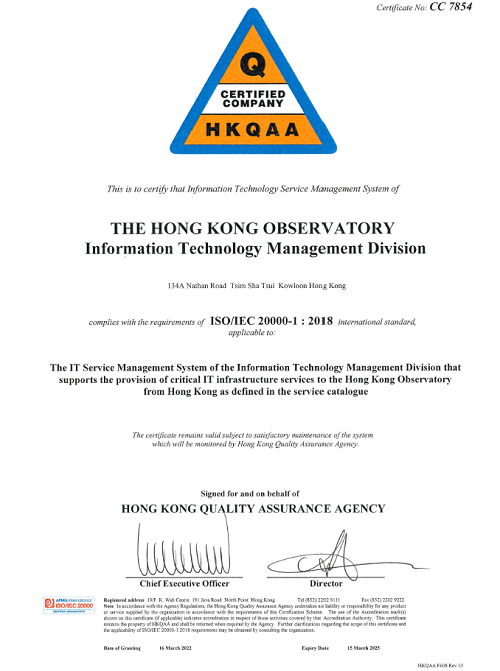
International Organisation for Standardization/International Electrotechnical Commission (ISO/IEC) 20000-1:2018 certification
Signed a Memorandum of Understanding (MOU) on Cooperation with the Solomon Islands Meteorological Service, the first MOU establishes with the official meteorological service of a Pacific Island Country.
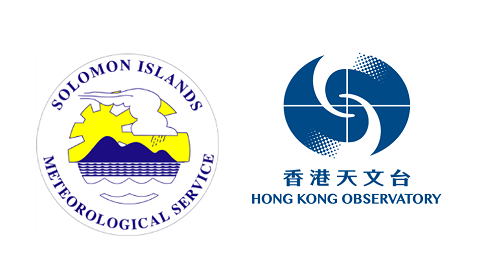
Enhanced the monitoring and announcement on the combined impacts of strong winds and prolonged rainstorms.
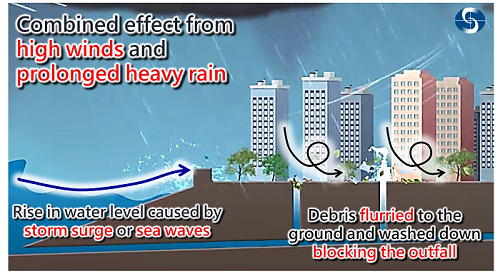
Tropical cyclones can bring about multiple hazards including high winds, heavy rain, storm surge, pounding waves, etc., adding up to significant combined effect
Launched a new “Special Weather Tips” to alert the public of persistent high temperatures.
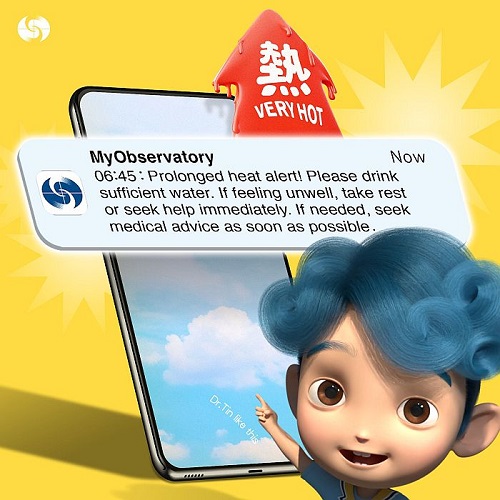
“Prolonged Heat Alert” associated with the Very Hot Weather Warning
|
| 2023 |
“Traffic Information” layer was added on the “Location-based Rainfall and Lightning Forecast” page of "MyObservatory" mobile app. The app also supported the receiving of the notifications of “Heat Stress at Work Warning” issued by the Labour Department.

MyObservatory added “Traffic Information” layer and supported the receiving of the notifications of “Heat Stress at Work Warning” issued by the Labour Department
The Backup South China Sea Tsunami Advisory Center (Hong Kong) (BSCSTAC), located in the Central Forecasting Office the Hong Kong Observatory, was officially put into operation.

Opening Ceremony of Backup South China Sea Tsunami Advisory Center (Hong Kong) officially commences operations
Addition of focal depth information to the earthquake reports.

A schematic diagram showing the hypocentre/focus, epicentre, and focal depth of an earthquake
Enhanced the Very Hot Weather Warning service with addition of new Special Weather Tips on "Extremely Hot Weather" on "MyObservatory".

“Extremely Hot Weather” Special Weather Tips during a Very Hot Weather Warning
Signed a Memorandum of Understanding on meteorological cooperation with Papua New Guinea National Weather Service.

The Director of the Hong Kong Observatory, Dr Chan Pak-wai (right), and the Director of the Papua New Guinea National Weather Service, Mr Jimmy Gomoga (left), signed a memorandum of understanding via videoconferencing to enhance collaboration and exchange in aeronautical meteorological science and technologies
China Meteorological Administration and the HKO signed the renewed arrangement on long term co-operation.

The Director of the Hong Kong Observatory, Dr Chan Pak-wai (right), and the Administrator of the CMA, Dr Chen Zhenlin (left), signed expanded “Arrangements for Long-term Co-operation in Meteorological Science and Technology”
Commencement of the preparation work for the Guangdong-Hong Kong-Macao Greater Bay Area Meteorological and Warning Center (Hong Kong).

The Chief Secretary for Administration, Mr Chan Kwok-ki (third from right); the Administrator of the China Meteorological Administration, Dr Chen Zhenlin (third from left); the Secretary for Environment and Ecology, Mr Tse Chin-wan (second from right); the Director of Guangdong Meteorological Service, Mr Zhuang Xudong (second from left); the Director of Macao Meteorological and Geophysical Bureau, Mr Leong Weng-kun (left); and the Director of the Hong Kong Observatory, Dr Chan Pak-wai (right), officiated at the commissioning launch ceremony
|
| 2024 |
The Director of the Hong Kong Observatory, Dr Chan Pak-wai, was elected as a co-Vice-President of the Commission for Observation, Infrastructure and Information Systems (INFCOM) of the World Meteorological Organization (WMO) at the third session of INFCOM held in Geneva, Switzerland. He is the first Asian to take up a leadership position in the INFCOM.

The Director of the Hong Kong Observatory, Dr Chan Pak-wai, was elected as a co-Vice-President of the Commission for Observation, Infrastructure and Information Systems (INFCOM) of the World Meteorological Organization
The Meteorological Training Centre for Belt and Road Countries was established, marking a significant milestone in enhancing the capabilities of meteorological professionals in the Belt and Road (B&R) regions and promoting future meteorological co-operation and development.

The Meteorological Training Centre for Belt and Road Countries was officially established
Updated a Memorandum of Understanding (MOU) with the World Meteorological Organization to further strengthen meteorological co-operation.

The updated MOU was signed by the Director of the Hong Kong Observatory, Dr Chan Pak-wai, and the Secretary-General of the WMO, Professor Celeste Saulo
Signed an expanded MOU on cooperation with the Solomon Islands Meteorological Service to further enhance collaboration and exchange in aeronautical meteorological science and technologies.

The MOU was signed by the Director of the Hong Kong Observatory, Dr Chan Pak-wai, and the Director of the Solomon Islands Meteorological Service, Mr David Hiba Hiriasia
Signed a MOU on co-operation with the Fiji Meteorological Service to enhance collaboration and exchanges in aeronautical meteorological science and technologies.

The MOU was signed by the Director of the Hong Kong Observatory, Dr Chan Pak-wai, and the Deputy Secretary of the Ministry of Public Works, Meteorological Services, and Transport of the Republic of Fiji, Mr George Faga Tavo
Launched a new version (3.0) of Severe Weather Information Centre (SWIC) website in early 2024 to provide the severe weather information worldwide and official warnings in contribution to the United Nations’ Early Warnings for All initiative.

Launched "Severe Weather Information Centre" (SWIC 3.0) website to display the severe weather observation information and official warnings around the world
The new Tai Mo Shan weather radar (TMSWR) was installed in March 2024 and has come into operation to provide essential observation data for monitoring various inclement weather conditions including thunderstorms, rainstorms and tropical cyclones.

The new Tai Mo Shan weather radar has come into operation
The reconstruction of the Tai Po Kau Tide Gauge Station was completed and operation commenced.

Tai Po Kau Tide Gauge Station in new design monitoring the tide level in Tolo Harbour
Added new function of "Special Weather Tips" (SWT) about the possible issuance of Tropical Cyclone Warning Signal No. 9 and weather information of the Greater Bay Area (GBA) to strengthen information dissemination.

More eye-catching notification of the messages related to Tropical Cyclone Warning Signals No.9 and 10 on "MyObservatory"

New services on "MyObservatory" – voice feature support for "Dr. Tin" and adding the weather information of the GBA
The North Airport Meteorological Office (N-AMO) of the Hong Kong Observatory, located at the New Air Traffic Control Tower of HKIA, and the meteorological facilities and services in support of the three runway system commenced operations.

Weather Observer conducting observation duties at the N-AMO
Two Cool Met Stuff episodes (episode "Carbon Multiverse" and "Flooding can occur even during Amber rainstorms") won awards (third prize in the short video category and the professional category) for the first time in 2023 China Science Film and Video "Kelei Cup". The "Kelei Cup" is known as the highest award for science film and video in China. This award recognizes the Observatory’s efforts in promoting science education.

Two episodes of "Cool Met Stuff" won awards in the China Science Film and Video "Kelei Cup"
|














































































































